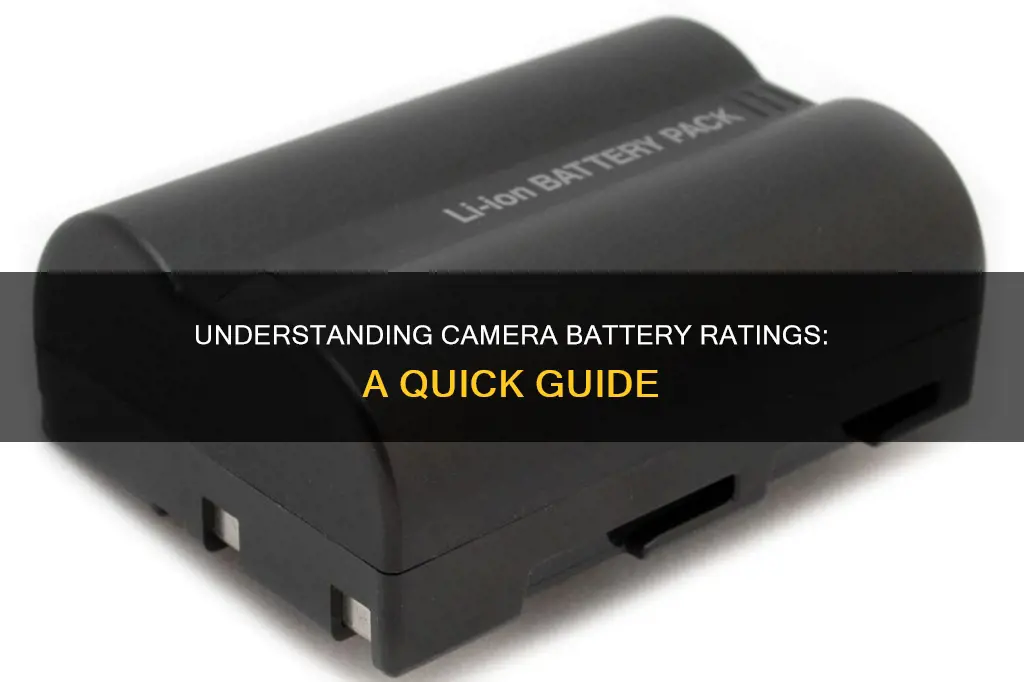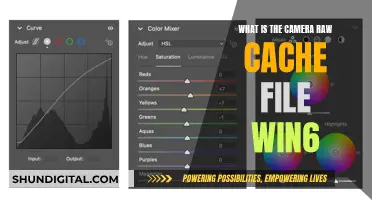
Camera battery ratings can be confusing, but they are essential to understanding how your camera works and how to get the most out of it. Every camera has a power rating, which can be found in the specifications. This rating includes the power consumption and rated voltage. Voltage, or potential, is measured in volts (V) and refers to the amount of current a battery can generate. Current is measured in amperes (A). These values are crucial in understanding how much power your camera draws and how long your battery will last.
The CIPA standard is a method used to determine the rated number of shots for a battery. This test involves taking a photo every 30 seconds, keeping the camera on between shots, and turning it off after every ten shots. However, this may not accurately reflect real-world usage, as it does not account for different shooting styles and camera settings.
Additionally, factors such as temperature, charging cycles, battery life, and current draw can impact a battery's performance. It's important to consider these variables when planning your camera battery setup, especially if you're relying on battery power for professional use.
| Characteristics | Values |
|---|---|
| Voltage | 7.2V or 7.4V |
| Power Consumption | Watt-hours (Wh) |
| Current | Measured in Amperes (A) |
| Power | Measured in Watts (W) |
| Power Rating | Depends on usage; minimum during 'idle' or 'standby' mode, maximum when all circuits are running simultaneously |
| Battery Life | Affected by discharge, charging cycles, current draw, and temperature |

Voltage and current
Voltage
Voltage is the force that pushes electrons (current) between two points to enable them to power something. It is also known as electrical potential. The higher the voltage, the more work the same number of electrons can do.
The voltage of a battery is determined by the chemical reactions in the battery, the concentrations of the battery components, and the polarization of the battery. The more electrons the negative terminal has compared to the positive terminal, the higher the voltage.
Current
Current is the rate at which electrons are flowing. It is the number of electrons passing through any one point of a circuit at a given time. The higher the current, the more work it can do at the same voltage.
In most batteries, individual battery cells are connected in series. For example, in lead-acid batteries, each cell has a voltage of about 2V, and six cells are connected to form a typical 12V lead-acid battery.
Most cameras specify their rated power clearly. This is usually measured in Volts (V) and Amperes (A). The power rating will tell you how much power the camera draws and, therefore, how much power you need your battery to supply.
Calculating Power
Power is calculated by multiplying voltage by current. The higher the power, the quicker a battery can do work.
How Do Disposable Cameras Work Without Batteries?
You may want to see also

Power rating
Amp-hours indicate how much current a battery can provide at a certain rate for a specific period. For instance, a battery with a rating of 200 Ah can deliver 20 amps of power at a constant rate for 10 hours. This can be calculated using the formula: Amp-hour = Current (I) * Discharge Time (T). So, for a current of 30 amps and a discharge time of 0.5 hours, the amp-hours would be 15 Ah.
Watt-hours, on the other hand, are calculated by multiplying the watts discharged by the number of hours. This represents the energy capacity of the battery.
When it comes to camera batteries, the power rating is usually listed in the camera's specifications. This indicates the amount of power the camera consumes. It's important to note that the current can vary depending on how you use the camera, with the minimum current during 'idle' or 'standby' mode and the maximum current drawn when all circuits in the camera are running simultaneously.
To determine the approximate runtime of a camera battery, you can use the formula: Hours = Battery Capacity in Wh / Camera Power Rating in Watts (W). However, this formula doesn't account for factors such as discharge, charging cycles, battery life, and current draw, so it may not be entirely accurate.
In summary, power rating is a crucial factor in selecting the right camera battery, as it indicates how much power the camera will consume and how long the battery will last under typical usage conditions.
Charging Your ADT Doorbell Camera: Quick and Easy Steps
You may want to see also

Battery capacity
To calculate the approximate run time of a battery, you can use the formula:
> Hours = Battery Capacity in Wh / Camera Power Rating in Watts (W)
However, it's important to note that this formula doesn't account for all the factors that can reduce a battery's energy capacity, such as discharge, charging cycles, battery life, and current draw. As such, a more complex formula may be needed for precise calculations.
Additionally, the way you use your camera will impact the battery life. For example, if you're taking photos continuously without reviewing them, the battery will last longer than if you're frequently reviewing photos on the LCD screen.
It's also worth mentioning that temperature can affect battery life. Lithium-ion batteries tend to discharge faster at higher temperatures. They generally perform best between 0°C and 45°C (32°F to 113°F).
When choosing a camera battery, it's recommended to have enough batteries to last for 24 hours of shooting. This ensures maximum reliability and helps prevent running out of power during a shoot.
In summary, when considering battery capacity, it's important to look at the Wh or mAh rating, use the appropriate formula to estimate battery life, and take into account factors such as temperature and usage patterns that can impact the battery's performance.
Charging the Digi Cool Camera: A Quick Guide
You may want to see also

Temperature
The standard rating for batteries is at room temperature (25°C/77°F). At freezing temperatures, battery capacity is reduced by 20%. At extremely low temperatures of approximately -22°F (-27°C), battery capacity drops by 50%.
Lithium-ion batteries, commonly used in cameras, have a stable voltage and a low self-discharge rate of about 10% at room temperature. However, they are volatile and have a chance of exploding if short-circuited, overheated, or not manufactured with rigorous quality standards.
Li-ion batteries discharge faster at higher temperatures. For example, at 40°C, it discharges at 15%. They perform optimally at temperatures between 0°C and 45°C (32-113°F). Below 0°C, the electrochemical processes within the battery slow down, leading to quicker battery exhaustion.
To maintain the battery's performance in cold conditions, you can keep them warm by placing them close to your body or using heating tapes. On the other hand, high temperatures can shorten battery life. According to the "rule of thumb" or the law of "Arrhenius," the corrosion rate will double for every 10°C increase in temperature, halving the battery's lifetime.
Therefore, when considering battery ratings, it is essential to factor in the operating temperature range to ensure optimal performance and longevity.
Doorbell Camera Battery Options: External Power Source?
You may want to see also

Battery life
When it comes to camera batteries, there are several factors that influence battery life and performance. Understanding these factors can help you make informed decisions about battery choice and usage.
Firstly, it's important to consider the power rating of your camera. This information can be found in the camera's specifications and will typically include the rated voltage and power consumption. The voltage, measured in volts (V), represents the potential for current flow, similar to a ditch trapping an enemy in an analogy. The higher the voltage, the greater the potential for current.
Current, measured in amperes (A), is the actual flow of electricity, akin to your enemy falling into the ditch and generating a current. The relationship between power, voltage, and current is essential, with power (W) being calculated by multiplying voltage (V) and current (A). Most cameras specify their rated power, and it's advisable to consider the highest rating to account for additional devices like the LCD screen or lens.
The type of battery also plays a significant role in battery life. Lithium-Ion (Li-ion) batteries, for instance, have become the industry standard due to their high energy density, low self-discharge rate, and stable terminal voltage. However, they are volatile and require strict manufacturing conditions to prevent the risk of explosion if short-circuited or overheated.
The energy capacity of a Li-ion battery is typically measured in watt-hours (Wh) or ampere-hours (Ah), indicating how many watts or amperes the battery can deliver per hour. This information is crucial for understanding the approximate runtime of a battery. Calculations can be made using the power formula: Wh = Voltage x Ah, or Ah = Wh x V.
Additionally, factors such as temperature play a role in battery life. Li-ion batteries tend to discharge faster at higher temperatures, with a discharge rate of 15% at 40°C. They perform optimally at lower temperatures, typically between 0°C and 45°C. Sub-zero temperatures can significantly reduce battery life, affecting the electrochemical processes and exhausting the battery much quicker.
When planning for a shoot, it's recommended to have enough batteries to last for 24 hours of shooting. This ensures maximum reliability and accounts for any unexpected delays or issues. Having a charger and backup batteries is also essential, especially if you're working in remote locations without immediate access to charging stations.
In summary, understanding the factors that influence camera battery life is crucial for photographers, especially those working in professional settings. By considering power ratings, battery types, energy capacity, and environmental factors, you can make informed decisions about battery choice and usage, ensuring your camera equipment is reliable and ready for any shooting scenario.
Drone Camera Battery Life: How Long Can You Fly?
You may want to see also
Frequently asked questions
DC power is supplied by batteries and DC generators, while AC power is supplied by portable AC generators and mains electricity. Both are measured in Volts and Amperes, but the way these are measured is different and sometimes finding a one-to-one correspondence is impossible.
Voltage is like a ditch that traps your enemy. The bigger the ditch, the greater the voltage. When your enemy falls into the ditch, they generate a current. Current flows.
Turn on the camera, and the battery icon will appear on the LCD monitor. If the icon does not appear, touch the 'DISP.' button several times to display it. An on-screen icon or message will indicate the battery charge level.







